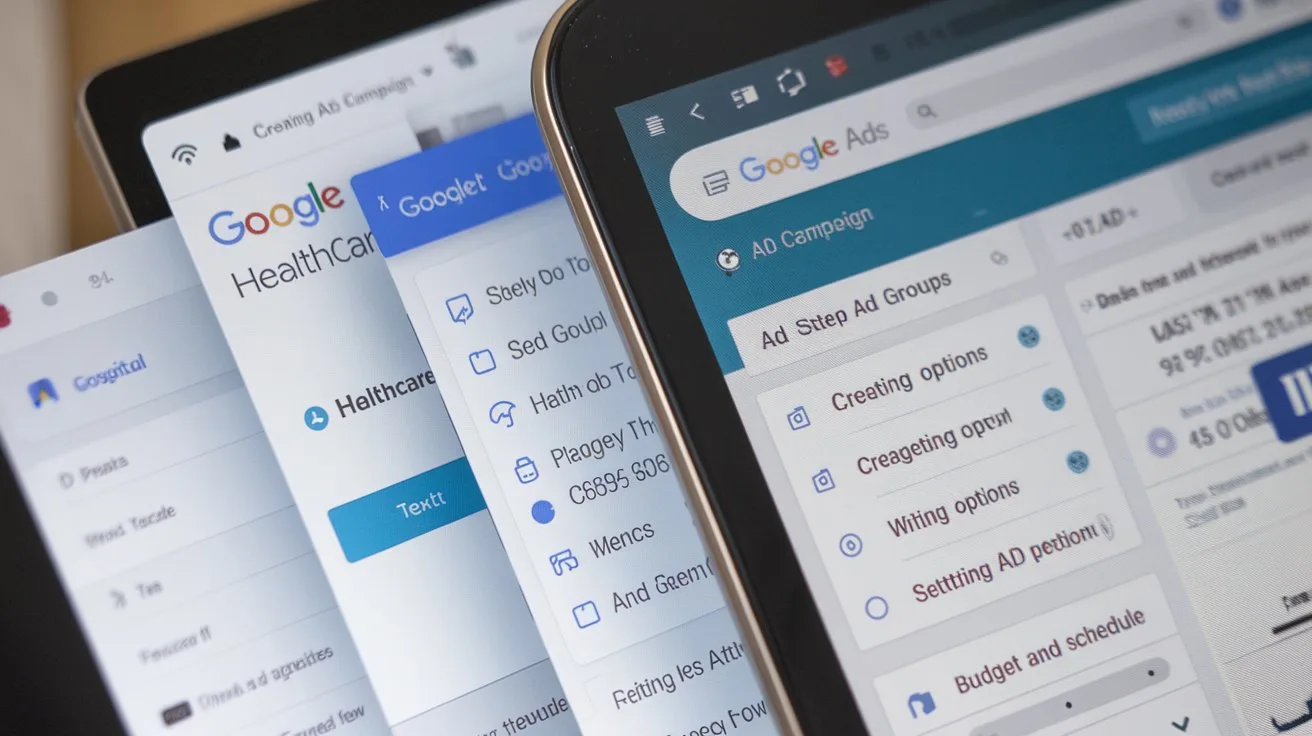How to Use Google Ads for Healthcare: A Step-by-Step Guide for Hospitals

Google Ads for healthcare is a powerful tool that allows hospitals to target the right audience, increase patient acquisition, and build brand awareness. However, healthcare advertising comes with strict compliance guidelines, and optimizing ads for the highest return on investment (ROI) can be challenging.
This step-by-step guide will help hospitals and healthcare marketers set up, optimize, and manage Google Ads campaigns while adhering to compliance rules and achieving the best results.
Why Google Ads for Hospitals?
1. Immediate Visibility
Unlike organic SEO strategies that take months to show results, Google Ads provides hospitals with instant exposure on search engine results pages (SERPs). When patients search for healthcare services like "best hospital for heart surgery near me", Google Ads ensures your hospital appears at the top of the results.
- How it Works: By bidding on relevant keywords, hospitals can ensure their ads are placed prominently in Google search results.
- Example: When someone searches for that phrase, a hospital running an ad for "emergency medical care in Mumbai" will appear above organic search results.
- Benefit: This visibility leads to higher click-through rates (CTR) and increases the chances of patient inquiries and appointments.
2. Highly Targeted Advertising
Google Ads allows hospitals to specifically target their ideal patients based on multiple factors, making their campaigns more effective.
- Targeting Options:
- Geographic Targeting: Show ads only to patients in a specific city, state, or within a particular radius of your hospital.
- Demographic Targeting: Focus on specific age groups, gender, income levels, and interests relevant to healthcare.
- Keyword Targeting: Reach users searching for "best cancer hospital in Delhi" or "pediatric specialist near me."
- Patient Intent: Google's AI analyzes user behaviour to serve ads to those actively looking for medical treatments or specialists.
- Benefit: Hospitals can spend their budget efficiently by ensuring ads are only displayed to the most relevant audience, reducing wasted clicks.
3. Cost-Effective with ROI Tracking
Google Ads is a pay-per-click (PPC) model, meaning hospitals pay when someone clicks on their ad. This ensures budget efficiency while providing measurable results.
- How it Works:
- Hospitals set a daily or monthly budget to control spending.
- Google Ads provides real-time Tracking of clicks, leads, and conversions.
- Cost Per Click (CPC) Optimization: Hospitals can reduce CPC and improve ROI by continuously refining ad targeting and keyword bidding.
- Example: A hospital spending ₹50,000/month on Google Ads can track the number of patients who book appointments, helping them calculate the cost per patient acquisition.
- Benefit: By analysing campaign performance, hospitals can adjust strategies to improve results and maximize patient conversions within their budget.
4. Compliance-Friendly Ad Format
Google enforces strict healthcare advertising policies to ensure ads comply with medical regulations, making it a trusted platform for hospitals.
- Key Compliance Aspects:
- Verification Required: Hospitals must be verified by Google to run ads related to healthcare services.
- No Misleading Claims: Ads cannot contain unverified promises like "Guaranteed Cancer Cure."
- Prescription Drug Restrictions: Only certified pharmacies and medical institutions can advertise prescription medicines.
- Patient Privacy: Ads must follow HIPAA and regional healthcare privacy laws, avoiding sensitive patient data.
- Benefit: Hospitals can confidently advertise their services without violating regulations, ensuring trust and credibility among potential patients.
Stats to Consider:
- According to Google, 77% of patients use search engines before booking a healthcare appointment.
- Google Ads generates 50% more conversions for healthcare businesses than other digital advertising channels.
- 43% of online patients who search for hospitals schedule an appointment within 24 hours.
Step 1: Setting Up Google Ads for Hospitals
1.1 Create a Google Ads Account
- Go to Google Ads and sign in with your Gmail.
- Set up your billing details and select 'New Campaign'.
1.2 Choose the Right Campaign Type
- Search Ads: Best for hospitals targeting local patients.
- Display Ads: Ideal for brand awareness and retargeting visitors.
- Video Ads (YouTube): Good for patient education and hospital promotions.
- Performance Max: Automated ads optimized by Google's AI.
1.3 Define Goals & Objectives
- Increase patient bookings
- Generate emergency service calls
- Promote specialized treatments
Step 2: Keyword Research & Targeting Patients
2.1 Find High-Intent Keywords
Use tools like Google Keyword Planner to specify high-volume keywords. Examples include:
- "How do you set up Google ads for hospitals?"
- "targeting patients with Google ads for hospitals."
- "google ads for patient acquisition in healthcare"
2.2 Use Keyword Match Types
- Broad Match: Shows ads for a wide range of searches.
- Phrase Match: Targets users searching for relevant phrases.
- Exact Match: Restricts ads to specific queries for high relevance.
2.3 Geo-Targeting Local Patients
Hospitals should focus on location-based targeting:
- Target cities or regions where the hospital operates.
- Use Google's Radius Targeting to reach nearby patients.
2.4 Audience Targeting
- Demographic targeting (age, gender, income level)
- Interest-based targeting (health-conscious users)
- Custom intent audiences (users searching for specific symptoms)
Step 3: Creating High-Performing Ad Copy
3.1 Writing a Compelling Headline
- Example: "Top-Rated Cardiac Care in Mumbai - Book an Appointment Today!"
- Include relevant keywords.
- Highlight patient benefits ("24/7 Emergency Services Available").
3.2 Crafting a Strong Description
- Example: "Get expert treatment from leading heart specialists. Immediate appointments are available. Visit [Your Hospital's Website]."
- Add urgency and a call-to-action (CTA).
3.3 Using Ad Extensions
Google Ads extensions improve visibility and engagement:
- Call Extensions: Display a phone number for direct calls.
- Location Extensions: Show hospital address and map.
- Site Link Extensions: Link to specific service pages (e.g., "Book Consultation").
Step 4: Ensuring Healthcare Google Ads Compliance
4.1 Follow Google's Healthcare Advertising Rules
- Hospitals must verify their ads with Google.
- Avoid misleading claims (e.g., "Guaranteed cancer cure").
- No promotion of prescription drugs without certification.
4.2 HIPAA & Local Regulations
- Do not use patient-sensitive data in ads.
- Ensure that landing pages comply with health privacy laws.
Step 5: Optimizing Google Ads for Hospital Websites
5.1 Landing Page Best Practices
- Ensure fast-loading, mobile-friendly pages.
- Include clear CTAs ("Schedule an Appointment Now").
- Add trust elements (testimonials, awards, accreditations).
5.2 A/B Testing & Performance Optimization
- Test different ad copies and keywords.
- Track CTR, CPC, and Conversion Rate.
- Use Google Analytics and Conversion Tracking.
Step 6: Tracking & Measuring Results
6.1 Google Ads Performance Metrics
- Click-Through Rate (CTR): Measure engagement.
- Conversion Rate: Monitor patient appointment bookings.
- Cost Per Acquisition (CPA): Optimize ad spend.
6.2 Google Ads Conversion Tracking
- Set up Google Tag Manager to track form submissions.
- Use call tracking to measure phone inquiries.
- Track ROI using Google Analytics Goals.
Final Thoughts
Google Ads for healthcare providers is a game-changer for hospitals looking to attract more patients. By following this guide, hospitals can:
- Set up compliant, high-performing ad campaigns.
- Optimize landing pages for better conversion.
- Track ROI and improve ad performance over time.
Start implementing Google Ads strategies for hospital marketing today and see a boost in patient acquisition and brand credibility!

FAQs
Google must verify hospitals before running ads.
No misleading claims like "Guaranteed cancer cure."
Prescription drug promotions require special approval.
Ads must comply with HIPAA and local data privacy laws.
Search Ads: Best for attracting patients searching for specific treatments.
Display Ads: Great for brand awareness and retargeting.
Video Ads (YouTube): Useful for patient education and testimonials.
Performance Max: AI-driven campaign for automated optimization.
Use high-intent keywords like "best pediatric hospital near me."
Optimize landing pages with fast loading speed and clear CTAs (e.g., "Book an Appointment").
Use ad extensions to highlight services, locations, and contact details.
A/B test different ad copies to identify the best-performing ones.
Google Tag Manager to track form submissions and appointment bookings.
Call Tracking to measure patient inquiries from phone calls.
Google Analytics to analyze user behavior and optimize ad performance.
Ensure compliance with Google's healthcare advertising rules.
Use keywords like "24/7 emergency hospital near me" to attract relevant searches.
Highlight quick response times and specialized emergency care.
Target specific countries where they want to attract patients.
Use multilingual ad copies for better engagement.
Highlight cost-effectiveness, advanced treatments, and patient testimonials.

Buddhisagar Bhosale
SEO Executive - Public Media Solution
Buddhisagar Bhosale is the SEO Executive at Public Media Solution, a leading marketing, PR, and branding company based in India.